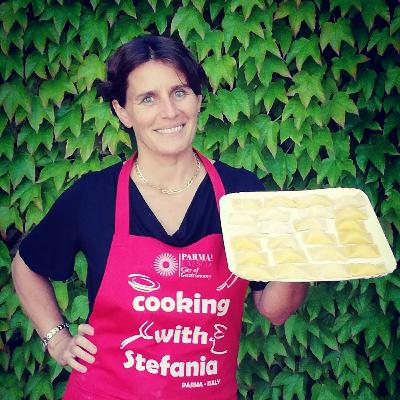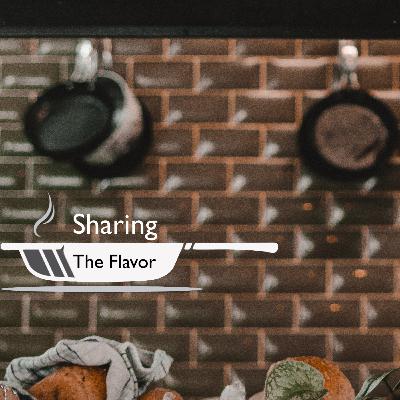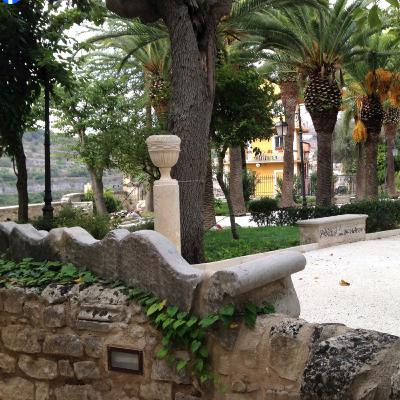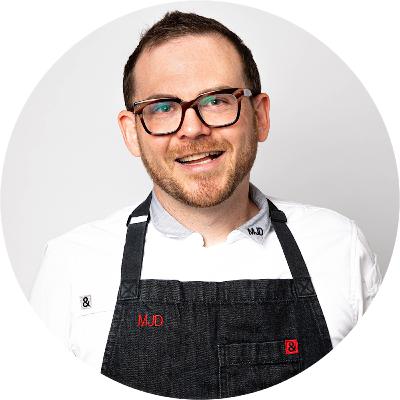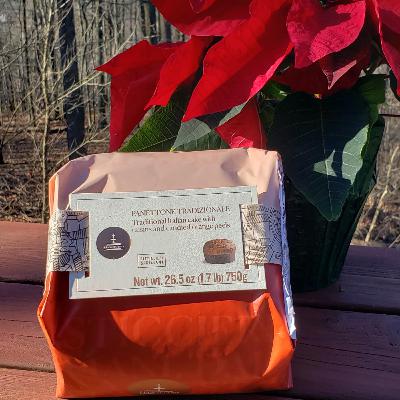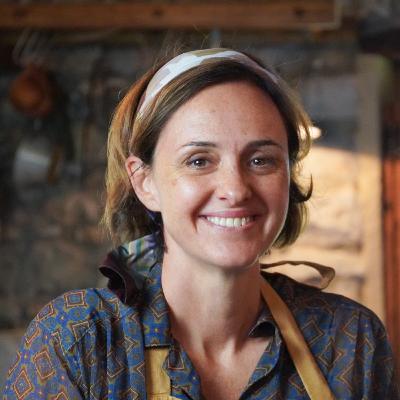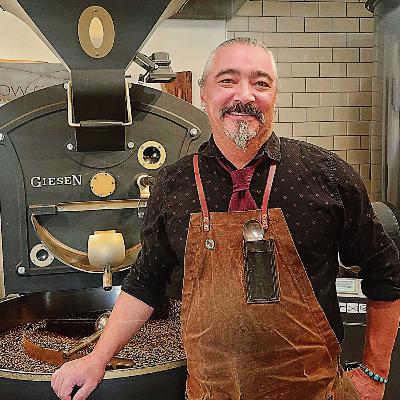Discover Sharing the Flavor
Sharing the Flavor

Sharing the Flavor
Author: Sharing the Flavor
Subscribed: 0Played: 2Subscribe
Share
© 2023 Sharing The Flavor
Description
A Podcast about creating Flavor. We explore flavor and show you the technique and history to go with the recipe. Show notes and links to recipes and technique videos can be found here: https://sharingtheflavor.com
28 Episodes
Reverse
This episode features a discussion of sensory science and how environment matters to how we perceive food and flavor. We are joined by Dr. Chris Simons of The Ohio State University's Department of Food Science and Technology.Chris’ research interests uses a multidisciplinary approach to understand the perception of foods and how they are processed to influence reward and behavior. Chris has a B.S. degree in Biology from the University of Oregon, an M.S. degree in Physiology from Portland State University, and a Ph.D. in Sensory Science from the University of California, Davis. Subsequently, Chris completed post-doctoral fellowships at the EPHE in Massy, France and the Dental School at the Universite Paris 6. From 2004 through 2012 Chris led the Sensory Research function at Givaudan Flavors Corp. and joined the faculty in the Department of Food Science and Technology at the Ohio State University in 2013.While completing his post-doctoral fellowship in France Chris had an epiphany about how environment can have an influence on how we perceive food and this has guided his research at OSU.We discuss traditional techniques to testing flavor and contrast that with new more immersive techniques promoted by Chris in the sensory lab and the affect it has on these tests.Environment does have an influence on our perception and we discuss that and more in this episode.MenuChris grew up in Oregon and is a fan of the Native American technique of cooking Salmon on planks over open fire. Check out the recipe for Cedar Plank Salmon and video of Celilo Falls.
Parma and Emilia-Romagna Cuisine with Stefania BertacciniThis episode features the cuisine of Parma, Italy which is in the culinary rich region of Emilia-Romagna. We interview Stefania Bertaccini who is a cook, teacher, food guide and has a passion for nature. She operates Stefania's Cooking Classes and Tours in Parma, and also provide cooking classes online.This region of Emilia-Romagna is an extremely important contributor to Italian cuisine. It is the "Food Valley" of Italy and features some of the best cuisine of Italy. Parma is a huge part of that.Parma is home to Parmigianno-Reggiano cheese, Prosciutto di Parma ham and Balsamic Vinegar to name a few of the most famous. Parma is also home to some other great cured meats like Culatello and Culatta, porcini mushrooms, truffles and many fundamental recipes for pasta, such as Anolini as well as the fried dough torta fritta. This is just the highlights of a list that is vast. Stefania guides us through the process of producing Parmigianno-Reggiano cheese and the history of the cheese. She also educates us on the aging of Parmigianno-Reggiano and the affects on taste and digestion.She then takes us on a tour of the production of Prosciutto di Parma and the artistic and meticulous process of aging the ham and the extremely unique process in Parma and the processing plants by the River EnzaWe next talk about the art of making Traditional balsamic vinegar DOP/PDO. Stefania's family produces traditional Balsamic vinegar in their farmhouse.Lastly we discuss the wonderful wine of Parma, LambruscoParma is a city of Gastronomy and has several food museums as well.Contacting StefaniaTripadvisorInstagramMenuParmigiano Reggiano CheeseProsciuttoBalsamic VinegarLambrusco
Tomato Sauce: Classic Recipes from Marcella HazanThis episode features a discussion of Tomatoes and some of the many Tomato based sauces in Italy. We feature recipes from the 30th anniversary edition of the great book by Marcella Hazan, Essentials of Classic Italian Cooking.The Essentials of Classic Italian Cooking cleverly introduces readers to the spectrum of classic Italian cooking including both simple and complex regionally based recipes. Hazan’s famed Tomato Sauce with Onion and Butter has already been featured in countless blogs online and is a true staple! Tune in to learn more about the wealth of delicious and accessible recipes Hazan shares with her (very fortunate) readers. Hazan also shares her techniques for working with either raw or canned tomatoes, basic sauces with garlic, onion, and butter. And flavor-filled sauces with pancetta, ricotta cheese and even porcini mushrooms.MenuTomato Sauce with Onion and ButterTomato Sauce with Olive Oil and Chopped VegetablesPasta with Pancetta & Dried RosemaryTomato Sauce with Heavy CreamTomato Sauce with Garlic and BasilBucatini all'AmatricianaTomato Sauce with Porcini MushroomsEggplant Sauce with Tomato and Chili PepperPasta With Fresh Tomato Sauce and RicottaMarcella Hazan's Tomato Sauce Recipe—& 8 Other Favorites
This episode features the cuisine of Turkey and the city of Istanbul. We interview Hardy Griffin and Banu Ozer Griffin who lived and enjoyed the cuisine of Turkey for years before moving to the US. Hardy is a writer of fiction, book reviews, and essays and translates from Turkish to English. Banu is a Lecturer of Turkish Language in the Department of Near Eastern Studies at Cornell University.Turkey is a cross roads of culture and cuisine and contributes a rich tapestry of taste to the southern Mediteranean area. Many people might know Turkey for Doner Kebap and Baklava but there is so much more to enjoy.Street food guideWe discuss the city of Istanbul, street food, restaurants and home cooking.Enjoy!In Movies and TvA Touch of SpiceThe Chef’s Table- NetflixCookbooksA Taste of Sun & Fire - Gaziantep CookeryFetured RestaurantsCiya SofrasıMenuKofteSimitAyranMidye DolmaPepper PasteHerbsDoner KebabPideBorekOlive oil dishesPomegranate SauceKumpir stuffed potatoesOkey card game
Cooking in Sicily with Chef Paulette LicitraThis episode features the cuisine of Sicily. Sicily is the largest island of Italy and is known for it's volcanic mountains and North African influence to it's cuisine and architecture. This Mediterranean island has spectacular beauty and has been featured in the public TV series Inspector Montalbano.We are joined by our friend, Chef Paulette Licitra. We disuss our Sicilian family heritage, her travels to the island and cooking experiences in Palermo and Ragusa. We delve deep in the cuisine, seafood, street food and certainly the sweets that Sicily is know for.Paulette discusses her travels and cooking in Sicily, including a visit to Capo Market in Palermo and cooking on a boat in the harbor.MenuScaccia RagusanaPork RaguAracinaPesto alla trapaneseCannoliBiscotti ReginaModican ChocolateEnjoy!
Cooking Essentials - Seasoning with SaltThis episode is the first in our series on the essentials of cooking. We begin by discussing seasoning and specifically, the use of salt before the cooking process, during the cooking process, and as a finishing touch. Salt in HistoryThis episode includes a history lesson on salt and features topics from the book Salt: A World History by Mark Kurlansky. The book is a great read to understand the cultural and societal importance of salt. Cooking with SaltWe also feature cooking-related tips about why we use salt and the best types of salt for cooking. We discuss techniques to use with salt for different cooking and baking processes from the following books.Ruhlman's Twenty by Michael RuhlmanSalt Fat Acid Heat by Samin NosratWe begin the cooking section by referencing the many forms of salt and their use in cooking, curing, brining and finishing.Enjoy!
From Michelin Kitchen to Classroom Professor with Matthew James DuffyThis episode features a discussion with chef and professor, Matthew James Duffy. Matthew is a classically trained fine dining chef that has a passion for breadmaking and teaches at the Centennial College in Toronto Canada.After graduating from University of Guelph, Matthew started his culinary career studying at Stratford Chef School.While attending school, Matthew was able to cook, during semesters of culinary practice, at Sooke Harbour House in British Columbia, Langdon Hall in Ontario Canada, Il Canto in Siena, Italy and Ichiban Ueno Osaka, Japan. He then had the opportunity to cook at Restaurant Noma in Copenhagen, Denmark followed by opportunities in Spain cooking for El Bohio in Madrid and Comerç 24 in Barcelona.After returning to North America, Matthew became a chef for Chef Daniel Boulud at Café Boulud NYC. After working in New York, Matthew was a Sous chef opening Café Boulud Toronto.After years of cooking at Michelin star restaurants, Matthew pursued a teaching career at Centennial College where he is Professor of Baking and Pastry Arts Management.Matthew has a micro bakery and shares this passion for Sourdough and baking online and has created a social media community of bakers. To stay connected with Matthew's latest content, sign up for his newsletter.Learn from Matthew:Matthew's YouTube ChannelRecipesSourdough GuidesOnline LearningEnjoy!
This episode features a discussion with author and cook, Paulette Licitra. Paulette, a native of Brooklyn, first started her career in theater and television production before pursuing an education in cooking at the Institute of Culinary Education in New York City. After her education at ICE, she pursued an internship and subsequent job at Lupa in the West Village of NYC.After working in the restaurant scene she then worked as a caterer in Midtown and also as a cook at Micol Negrin's Rustico Cooking in NYC. Paulette then moved to Nashville Tennessee and started teaching cooking classes there. She has appeared many times on television in Nashville as well as performs music with her partner Duane in their group, Duette.Paulette conducts classes in person and online and also organizes Italy culinary tours. You can reach Paulette at her website, Chef Paulette.Paulette's published books are:The Easy Italian Cookbook: 100 Quick and Authentic RecipesItalian Cooking PartyLinks for topics discussed:La Caffettiera Cafe in RomeNonna Betta Rome RestaurantRistorante La Campana - RomePizzeria Tavola Calda Felice e Silvana (Rome)Enjoy!
A Panettone ChristmasIn this episode we discuss the King of Breads, Panettone. This pastry bread is the tradition for Natale (Christmas) and originated in Milan. It's unique in its tall size and has a dome shape and candied citron. Many of us have had boxed panettone that are stale but if you try a fresh panettone, it's completely different. The history of panettone dates back to the Romans to panem triticum which was a loaf of bread sweetened with egg and raisins.During the Middle Ages, in Milan families celebrated Christmas was celebrated with three large loaves of wheat bread. In 1395 was issued that all bakeries in Milan must make a pan de’ sciori or pan del ton available to all on Christmas.The history of panettone is also legend and there are three versions of the legend.Legend of PanetonneThe first legend is in 1495 in the court of Ludovico il Moro. A young (14 year old) baker named Toni is assigned to prepare the dessert. He sadly falls sleep and burns the cake which sends the head chef into a rage. To save himself he uses a piece of butter saved for his mother for Christmas to make the soft bread with eggs and sugar. The chef and Ludovico il Moro are delighted. Toni was not credited by the chef but news travels to the city of the creation of the pan de Toni.The second legend surrounds the love of Giacomo Atellani and Adalgisa, a daughter of a baker in Milan. The Atellani do not approve of the wedding because the bakery poor fortunes. Giacomo secretly decides to work for the bakery to make a bread with sugar, butter and candied citron. The bread is a success and become famous and this convinces Ughettos's love of Adalgisa.The last legend is that of a group of nuns and Sister Ughetta. As Christmas approaches she decided to prepare a cake that will comfort her sisters during the Christmas holidays. The cake, a mixture of sugar, eggs, butter and candied citron satisfies the nuns and become popular throughout Milan.Panetone is not just for ChristmasPanettone is given as gifts and is celebrated during the Christmas holiday. The Milanese are known to hold onto leftover panettone and eat it on February 3rd for celebrating Saint Blaise https://italoamericano.org/panettone-san-biagio/Making Panettone is a labor of loveThe process of baking panettone is involved and starts with a lievito madre, a stiff dough that is the starter for the bread. It is a special version of a sourdough starter. The lievito madre is mixed with egg, flour and butter and worked for three days making multiple doughs before baking. The unique baking process of panettone involves cooling it by hanging the panettone after baking, which helps preserve the dome shape, and cools for 10 hours.Creating Lievito Madre (Pasta Madre)Don't have time to make panettone, here are some great artisnal ones you can buy. Or you can buy less expensive ones that are still very good
This episode features a discussion with author and cook, Enrica Monzani. Enrica is the author of the blog, A Small Kitchen in Genoa. Enrica has a new book out called Liguria in Cucina. In the book she explores the culinary regions and foods of Genoa, the Italian Riviera and the vast Forest areas of Liguria. We go beyond Pesto and Focaccia to explore the diverse culinary regions and flavors of Liguria.Topics discussed:· The Regions within Liguria and the influence on cooking (The Sea, The Forest, the Mountains)· The pantry of Liguria · Olive Oil of Liguria· Pesto origins and Salsa di Noci· Chickpea flour (Panissa, Farinata)· The unique Pasta of Liguria (use of white wine)· The many forms of Focaccia (Focaccette al Formaggio, Sardenaira)· The savoury pies of Liguria (Torta Pasqualina )· Fish (Anchovies}, Mussels)· Ligurian DessertsEnrica also hosts cooking classes and food tours of Genoa.To learn more about Enrica and buy Liguria in Cucina today, head over to A Small Kitchen in GenoaEnjoy!
Roasting Coffee with Cutbow CoffeeIn this episode we interview Paul Gallegos of Cutbow Coffee in Alburquerqe New Mexico. Paul was trained in roasting at Peet's coffee and has been roasting coffee for 30 years. Paul shares with us the history of Peet's coffee and their early relationship with Starbucks. He talks about the specialty coffee movement started by Alfred Peet. He mentions how, at the same time in the 60's, the Berkley California scene also started the Farm to Table movement, with Alice Water's Chez Panisse. Paul educates us on coffee varieties and cultivation and the bean belt of countries across the world that produce coffee. He discusses about the care needed in selecting coffee and how it is similar to wine making.Giovanni and Paul discuss Italian coffee roasters such as Illy and Sant'Eustachio. They also discuss the region of Trieste, which is the most known region of Italy for coffee productionWe also delve into the roasting process and how this imparts flavor into the coffee before the coffee drink is made. A show cannot be complete without a food reference and Paul mentions a recipe for short ribs with coffee.Enjoy!
In this episode we discuss the celebrations surrounding All Saints Day(November 1rst) and All Souls Day (November 2nd). From Mexico's Dia de Los Muertos to Italy's regional celebrations we disuss the traditions and food associated with these days of remembrance.Vanessa guides us through the celebrations in areas like Atlixco where altars are decorated and celebrations include Pane de Muerto.Gio discusses traditions in north and south Italy and some of the regional foods. Gio also mentions that Abruzzo has celebrations that include Jack O'Lanterns.We discuss Italian food from Minestra di Ceci Soup and Pan dei Morti in the north to the wonderful sweets of Naples and Sicily like Ossa dei Morti and Rame di Napoli. In Marche there is a biscuit recipe for Fave dei Morti.Vanessa features at the end a great chocolate cookie recipe from Naples called Biscotti Toto.Enjoy!The MenuPan de Muerto. Minestra di CeciFave dei MortiBiscotti Totò
Italy Roadtrip - AbruzzoIn this episode we continue our trip to the north and visiting the eastern central region of Abruzzo. Abruzzo is situated due east of Rome and stretches from the Apennine mountains (including Gran Sasso) to the Adriatic Sea. This give Abruzzo the benefit of mountains as well as seafood along it's coast.Abruzzo contains mountain ski resorts like Campo Imperatore as well as towns such as l'Aquila that date back to Middle Ages and Renaissance. Along the Adriatic you will find the coastal port city of Pescara.While not a widely know region for culinary items, Abruzzo has made its contributions to cuisine of Italy.Abruzzo is considered a southern region of Italy, even though it is central. Abruzzo is known for it's high quality Saffron of l'Aquila, Colline Termane Olive Oil, Liquorice of Atri, and Honey. They are also know for Truffles, Lamb and Rosemary. Check out this video on the honey of Abruzzo.Abruzzo is also known for their Salumi, like Mortadella di Campotosto, Spaghetti alla Chitarra and Torrone. To make Spaghetti alla Chitarra you use a Pasta Chitarra (Guitar).Enjoy!The MenuPallotte Cacio e Uova. Fregnacce AbruzzesiScripelle MbusseSpaghetti alla ChitarraCiabottoArrosticiniFerratelle and Coperchiole Abruzzesi con Miele e Noci
Cucina Povera with Giulia ScarpaleggiaIn this episode we are in Tuscany and talking with author and food blogger Giulia Scarpaleggia. Giulia has a new book available called Cucina Povera.We discuss her blog Juls' Kitchen as well as her studio and cooking classes.We discuss Tuscan cooking and importance of bread making and use of stale bread in Tuscan cuisine. Along with bread we discuss cured meats and the great Salume of Tuscany. We discuss the unique Chestnut flour and pasta and desserts made from this flour. Lastly we discuss the Tuscan diet and the importance of beans in Tuscany.About GiuliaJuls' KitchenCooking with an Italian Accent PodcastCucina PoveraLetters from Tuscany NewletterEnjoy!The MenuPappa al PomodoroLasagne bastarde di castagne con sugo di nociCastagnaccio, a Tuscan chestnut cakeTuscan fagioli all’uccellettoRibolitta
Italy Roadtrip - Liguria/Italian RivieraIn this episode we continue our trip to the north and visiting the coastal region of Liguria. Liguria is home to the city of Genoa as well as the Italian Riviera, which is famous and includes the Cinque Terre (five lands), Portofino as well as other coast cities. Check out this Eva Celine Youtube on the area.Liguria Cuisine is famous for Focaccia, Pesto and Seafood.We talk about how to make Focaccia at home and also commented on professional chefs making it from famous bakeries like Marinetta and Michelin star restaurant The Cook. Check out this video on Focaccia Genovese from Marinetta. Here is a video on how to make Focaccia di Recco.We highlight a dish made by Vanessa called Polpettone di fagiolini e patate from the website memoriediangelina.com. This is a fabulous "loaf" of potatoes, green beans and cheese.For Seafood we discuss Ciuppin (seafood soup) as well as Muscoli Ripieni (stuffed mussels). This recipe for mussels is from Grazia Andreotti of the restaurant Da Aristide.For dessert we discuss Sciacchetra wine and Canestrelli cookies.Lastly Vanessa introduces us to a hilarious book, A Certain Hunger for which she did a recent blog post. Be sure to check it out!I'm a Pixar fan and here is a story behind the movie Luca, which is based in Cinque Terre.Enjoy!The MenuFocaccia. I used this youtube from Preppy KitchenPasta alla...
Italy Roadtrip - Valle d'AostaPlease support Emilia-RomagnaThe region of Emilia-Romagna was devastated by the worst flooding in 100 years. Emilia-Romagna is one of the most important agricultural regions in Italy, and this disaster had a huge effect on the economy as well as the health and safety of the people of that region. For more information on the floods, you can read this article from The Guardian as well as one about the current clean up efforts and EU efforts to help. The Local has a list of ways to give to help this area.Thank you, now on to the episode...In this episode we continue our trip to the north and visit the smallest region of Italy, Valle d'Aosta, which borders Switzerland and France's Mont Blanc. The area is incredibly picturesque and has a single city, Aosta. The area is known for the castles and forts that are in the valley hillsides. Fort Bard is an example and was discussed in the show. It is also known as a destination for skiiing. Check out this video of the area.Valle d'Aosta features Alpine and French influenced food. Polenta, Beef, Cheese and Salumi and Chestnuts are widely used in the area for food. The area is known for the amazing milk produced and this is a big part of cheese production.We highlight Fontina cheese which is the most important cheese from the area and is used in many dishes. From Fonduta to Polenta, Risotto and cheese boards it is a great and versatile cheese.We also discuss a dish called Carbonade which is commonly served with Polenta.For dessert we discuss Mont BlancFor our episode Vanessa made Risotto Alla Valdostana using Fontine cheese and I made Risotto al Salto.Enjoy!The MenuCheese Board with Fontina, Toma, Lardo and BresaolaFonduta alla ValdostanaCarbonade...
Italy Roadtrip - Piedmont Part 2Please support Emilia-RomagnaThe region of Emilia-Romagna was devastated by the worst flooding in 100 years. Emilia-Romagna is one of the most important agricultural regions in Italy, and this disaster had a huge effect on the economy as well as the health and safety of the people of that region. For more information on the floods, you can read this article from The Guardian as well as one about the current clean up efforts and EU efforts to help. The Local has a list of ways to give to help this area.Thank you, now on to the episode...In this episode we continue our trip to the northwest region of Piedmont. We explore Wine, Risotto, Beef and Hazelnuts.Piedmont is one of twenty regions of Italy and it one of the top three of culinary importance.Piedmont is so vast and important as a culinary region of Italy that we needed to do a second episode to discuss the wine making of the region and the use of wine in cooking. We also discuss Hazelnuts and a rich cake dessert.Piedmont is one of the most important wine growing regions in Italy and the world. Known for the Nebbiolo grape and the wines of Barolo, Barbaresco, Barbera and Dolcetto. Wine is also used extensively in the cuisine of the region as well.For our episode, Vanessa made her variation of a Risotto al Barolo, called Risotto al Barolo e salciccia. I made the main course of Brasato al Nebbiolo, a rich braised beef dish served over Risotto. Vanessa also made our dessert, a decadent Torta di noccioli e cioccolato con crema.For the dessert, Gio recommended having the following Barolo dessert wine called Barolo ChinatoLastly, we have this phrase Vanessa referenced from Anthony Capella that are words to live by: “Anni, amori e bicchieri di vino, nun se contano mai.”’ ‘“Years, lovers and glasses of wine; these things must not be counted.”Enjoy!Our Menu for this Episode[20:25] Risotto al Barolo e salciccia[27:14] Brasato al Barolo (Nebbiolo in my case)[36:35] Torta di noccioli e cioccolato con cremaa...
Italy Roadtrip - Piedmont Part 1In this episode we begin our roadtrip of Italy with a visit to the northwest region of Piedmont.Piedmont is one of twenty regions of Italy and it is one of the top three of culinary importance.The capital city of Piedmont and the former capital of Italy is Turin, which is also home of the car maker Fiat and the Lingotto.Piedmont is known for risotto rice, razza piemontese beef, white truffles and award winning wines Here is a guide to top foods in PiedmontTruffles are very prized and expensive, the Alba white truffles being some of the most expensive. Here is an example of a White truffle auctionMaking the Tajarin pasta was fun, we've included the video that I used and here is a great video of a Pasta Granny making TajarinVanessa made a tremendous Vitello Tonnato. We feature the recipe here.We also make several references to the author Umberto Eco and Vanessa's favorite quote "Ma gavte la nata" (take out the cork and let the wind blow away)Our Menu For This Episode[14:30] Bagna Cauda[20:00] Tajarin Pasta with Butter and Sage[27:52] Vitello tonnato[39:00] BonetRecipe for this episodeTechnique for this episode
Italian Food MisconceptionsIn this episode we explore some common misconceptions related to Italian food and also discuss current trends in the Italian food scene.Here are some hilarious videos on pasta trees and pizza farms.We first discuss an American favorite, Spaghetti and Meatballs which is not a traditional Italian dish but rather has its origins in New York. The recipe is based on an Italian dish called Polpette, which is Italian for meatballs. While Polpette can be cooked similar to Italian/American Meatballs, they are really more similar to croquettes and can be made using poultry, fish and even veggies.Along with Spaghetti and Meatballs we also discuss Chicken Parmesan, which is not Italian, but I like making it. Parmigiana di Melanzane (EggPlant Parmesean) is Italian.Fettuccine Alfredo is definitely not traditional Italian as well.Pepperoni Pizza is not Italian, ordering that might get you a pizza with pepperoncini peppers on top. Here are a list of Pizzas and the closest to the American Pepperoni is Diavolo (with spicy salami). Giovanni mentions that Pizza with Sausage and Broccoli is great. Here is a recipeWe also discuss some tradtional Italian norms/rules for cooking and dining. this article interviewing Ialian expats offers reactions to American customs assumed to be Italian. Some general rules:PastaNo oil is added to boiling water for pastaDon't put cheese on a seafood pasta recipeMatch the pasta shapes to the specific sauce and some can never be combinedPasta is always al dente (slightly undercooked)You finish cooking pasta in the sauce. You never dollop sauce on top of pastaCoffeeCappucino is drank in the morning, with Cornetti (Italian Croisssants)Cappucino is not drank in the afternoon and never after a mealDrinking a Latte is not a thing (It literally means milk)We also discuss cured meats and the fact that for 40 years, curied Italian meats were not allowed in the US. There are some that are allowed now. We talked about an incredible place in Greve in Chiant. Macelleria FalorniLastly we discuss that lifestyles are changing in Italy and that the cost of good ingredients is rising and, as a result, less cooking is happening in homes. There is also a rise in a...
Apertif and DigestifIn this episode we explore the relationship of drinking before and after eating and specifically apertifs and digestifs.We first discuss the famous Negroni mix drink which was a created in 1919 at the Caffe Casoni in Florence. This drink was a variation on the Americano, which was the first drink referenced in a James Bond naovel. Count Camillo ordered an Americano made with Gin in place of Soda and invented the Negroni. Here is a great Youtube video from Rita Cocktail Bar in Milan about the Negroni. Both the Negroni, Americano and a host of other Italian cocktails have red colored Campari as a key ingredient.We also discuss apertifs, drinks served before a meal to stimulate the appetite. They typically are less sweet and involved herbs and other ingredients to stimulate ones appetite.After a meal is the time for a digestif, which are often characterized by higher alcohol content and deep rich flavor profiles. Italy is known for Limoncello and Grappa.We also talk about liquors and their use in cakes. Gio mentiones walnut liquor and sour cherry liquors.Lastly we mention a wonder Neopolitan dessert called Baba.Salute!Recipe for this episodeTechnique for this episode



